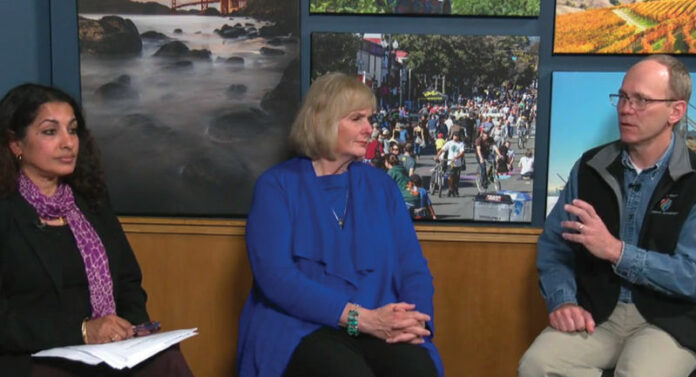
The latest updates on the spread of COVID-19, the novel coronavirus, are filled with tough news for local communities and businesses, but was made with the intention of “flattening the curve,” the new buzzword. Sonoma County is now under a mandatory order from the county health officer to shelter in place for the next three weeks.
The order went into effect on March 18 at midnight and is meant to assist in “social distancing,” another new buzzword of the pandemic.
“That means that you stay at home and don’t leave unless do so for essential activities or to work in essential businesses or for essential travel,” said Dr. Sundari Mase, interim health officer for Sonoma County.
A list of what qualifies as “essential,” is available at our website at sonomawest.com.
Flattening the curve is a reference to a graph showing the general path of an outbreak. Without social distancing, the curve is very tall and thin, and medical services are overwhelmed. However, by practicing social distancing the curve becomes longer and less vertical. While the total number of infected may not change significantly, medical services are not overwhelmed.
As of press time, the morning of March 18, there were six diagnosed cases in Sonoma County, according to Dr. Sundari Mase, the county’s interim public health director. Two are from the Grand Princess cruise ship; one is believed to be travel related; two are so-called community transmission, meaning that they picked it up out in the community without there being a direct connection to an exposed person. The origins of one case are still unknown.
Statewide, there are 472 cases and 11 deaths. Twenty-four are from repatriation flights, 82 are travel-related, 75 are person-to-person transmissions, 98 are community-acquired, 193 are currently under investigation and eight are unknown.
Most of the cases are affecting an older demographic, with 116 cases in the 65-plus population, and 210 in the 18-64 age group. Globally, there are 153,517 cases, with 5,735 deaths, in 143 countries.
At a town hall on that took place on March 17, broadcast on KRCB, Mase, chair of the board of Supervisors Susan Gorin and Office of Emergency Services Director Chris Godley answered questions about the shelter in place order.
They emphasized that while they were very serious about the order, it is not a “lockdown.”
“This is not a lockdown,” Mase said. “In fact, people will be able to go outside of the house for medical care, to the pharmacy, the supermarket, take your pet to the veterinarian and you’ll definitely be able to go out for a walk to parks and you can get in a car.
“The whole point, however, is to keep people at home as much as possible,” she continued. “It’s OK to get some peace of mind and go outside the house, but if you do, you should minimize the distances traveled and minimize the number of persons you come into contact with. So, social distancing, keeping six feet away from people around you when out and about, would be great.”
Because it’s not a lockdown, the town hall panel emphasized that hoarding or stocking up on groceries and supplies was not necessary — the stores would remain open and grocery shopping was still allowed.
The declaration came on the heels of the first case of community transmission. In a press conference on March 15, county officials confirmed that the first case of community spread of COVID-19. The infected individual is an employee of Rohnert Park Medical Centers, and individuals who have been in contact with that person are in the process of being notified, according to Mase. Another person who has been in direct contact with the infected subject has been tested and is in self-quarantine.
The community transmission cases were found via the recent increased surveillance testing program, which Mase started on March 12. The positive test was found on March 14.The additional cases were confirmed the next day.
Mase declined to answer repeated questions about the original positive person’s job within the hospital, where they might have been in the county or whether they were symptomatic, citing HIPAA rules. The question came up again in the town hall on March 17, and again, it was deflected over HIPAA concerns.
“We really can’t release information, due to patient confidentiality,” Mase said. “If they were the person or the case, they wouldn’t want it out in public either. We can’t release identifying factors. We’re doing everything we can to identify people who they have come in to contact with and asked them to self-quarantine and to report any symptoms or fever. Staff has contacted all of them, we want people to be reassured that we are doing everything we can.”
Some of the questions raised the issue of whether or not the county was “a step behind” in issuing the order, since six other bay area counties had made their declaration a day earlier. Both Mase and Godley pointed out that there are significantly fewer cases in Sonoma County, compared to places like Santa Clara. As a result, while the declaration may be chronologically later, in terms of the declaration compared to the number of cases, it’s actually happening much sooner.
According to Mase, the community positives have come to light through the increased surveillance testing. There have been 168 persons tested so far, with 151 negatives. There are another 18 individuals still under investigation.
The availability of testing was brought up repeatedly in questions to the town hall panel, including questions about the availability of tests and concerns that the current numbers are artificially low due to inadequate testing. This is of special concern given the growing scientific evidence that asymptomatic people can spread the virus.
“It’s a hard question because we do need to use the tests and our resources — not just the test kits, but the swabs, the test tubes, the protective gear, the workers performing the tests — we need to make sure we preserve these resources for the people who are ill and symptomatic,” said Mase. “We’re not going to know how many cases there are among people who are asymptomatic until we go out and test everybody, and at this time that is not the plan in the county.”
When pressed, Mase stated that the public health lab has the capacity for 100 to 120 tests a day, with additional support from local private labs at Quest and LabCorp. She defined this capacity as sufficient for the needs of the county.
At the town hall, there was an extensive conversation about the health care capacity of the county. There are plans in place to start ramping up capacity with additional quarantine and hospital space.
According to Godley, there are approximately 800 hospital beds in the county, and 76 of those are ICU beds. But, “its important to note they are not just lying empty,” he said. “We operate them at 90% full all the time, because that’s what we built to make sure we can accommodate the regular needs of our community. So, when we talk about the surge that’s what we’re talking about — ramping up acute care facilities and interventions for individuals that may be seriously ill.”
Gorin added that the board of supervisors approved $1 million in funding to help support those activities. “We know personnel and communications are expensive, but we are really able and willing to devote some of our reserves to evaluate the needs Chris talked about,” said Gorin, “and address the gaps that we may see if the curve fails to flatten.”
Mase reiterated that all the recommendations that have been made thus far — hand washing, careful hygiene and social distancing — remain the best defense, and that those recommendations remain unchanged. Similarly, they continue not to recommend the use of masks, because they require extensive and careful fitting, and can potentially increase the risk of exposure if improperly fitted.
While defying a medical order is considered a criminal misdemeanor, there are no plans for a harsh level of enforcement yet, according to Godley. Rather, they’ll focus their enforcement on institutions rather than individuals and on warnings and civil injunctions rather than prosecution.
Mail delivery, from USPS as well as UPS and FedEx, will continue during the shelter in place order. Laundromats will also be open. Gorin said that while there wasn’t currently a moratorium on evictions, it was something they planned on discussing. She pointed out that landlords were at much as risk as tenants and that solutions were being discussed at all levels of government.
However, on the same day, the Sonoma County Sheriff’s Department made a statement that they would not be enforcing evictions during the order.
Plans for the homeless are also not set in stone, but the county is encouraging the homeless to shelter in place at the various shelters around the county. The order exempts unsheltered individuals. In addition, the panel at the town hall stated unequivocally that the undocumented population would not be subject to any enforcement.
While the coming weeks are uncertain, the county wants to allay fears while pressing the importance of obeying the order.
“We have to acknowledge we’re facing a pandemic, and we have to take it seriously and make a social compact not to put anyone else at risk,” said Gorin. “No matter the age range, social gathering is a risk.”
“I have something to say to the community,” Mase concluded. “I want to let people know that this is a very important order. I know it will be hard for the community to shelter in place but we have to, each one of us, do our piece. I would like to ask everyone to follow this order, because we need to get over this pandemic, and this is one way we can do it, so we need your help.”







